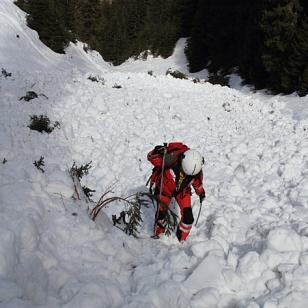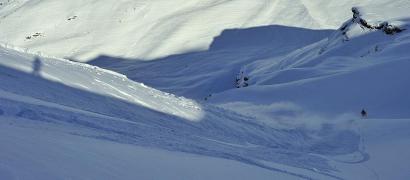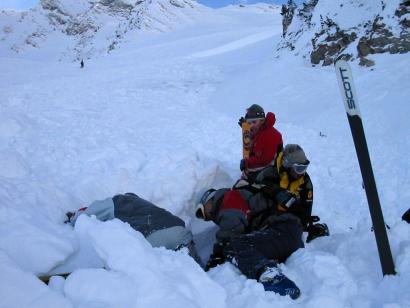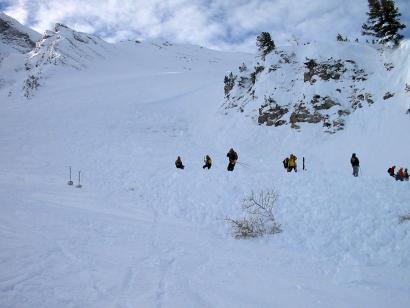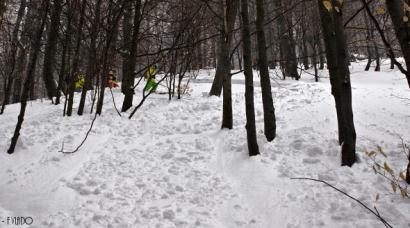Avalanches
We as the Czechs don’t have bog mountains and so we get our experiences with avalanches abroad, that’s why our skills in avalanche prevention significantly decreases. Avalanches are mostly about observing and progression of conditions, which change in time and because of that we have no other option than trust webcameras, weather forecast and published level of avalanche risk. Next thing which is against us is distance to mountains – If we travel longer distance and the conditions aren’t ideal we hardly ever adjust riding to them or even go home. All of these aspects hinder us to decide and evaluate the situation.
The basis for the emergence of avalanches are snow layers which are connected in different natural conditions (temperature, wind, direction of the slope etc... ). Thanks to these attributes segmentation of the mountains, hills and walls change that attributes singificantly and so not even dig of a snow probe (cut of a snow probe shows what snow fell in the past and what happened to it. It’s watched connection of layers and it’s mutual movement.) doesn’t mean that the situation is equal about 20 metres away. The same thing applies for the avalanche risk – when is announced the third level of avalanche risk it doesn’t mean that on a slope when the conditions change will still be the third level. Conditions in mountains still change, from hour to hour, so condition which seemed to be alright in the morning could be dangerous in the afternoon. All of these and many other information should everyone have trained in theoretical form e.g. (there is avalanche risk due long frost, when temperature is +°C it’s more dangerous to ski in the forest which takes heat into it’s roots, difference in sun-shadow etc). A requirement is to your theoretical preparation was good enought that you’d say that we won’t ride down this slope, we’ll ride down another and somewhere else or we don’t do freeride today. After daylong riding and jumping tricks and drops will man get to an euphoria – flood of adrenaline and he realizes these avalanche signs and indications when it’s to late.
The prevention is not to get into an avalanche, if everything fails and you’re in the avalanche in first few moments you can rely only on yourself and you equipment. If you get into an avalanche in first few moments after pull down of avalanche you don’t understand what’s going on and you’re trying to grab something, even the snow which is moving with you. Then you launch your ABS or SNOWPulse backpack. If you don’t have it you don’t launch anything, you just horror scream and are in a washing machine. On the end if you’re conscious the avalanche starts to slow down and that’s the only chance when you can still move, in this moment you try to get up at least with a hand (if you know where up is). Avalanche can also brake your bones because it’s power is really huge. If you had SnowPulse or ABS backpack and everything functioned as it should have, you are at least with a part on the surface.
Here I’m getting to avalanche equipment. I’d start with already mentioned backpacks. On the market we have two main players – SnowPulse and ABS. Principle of these backpacks is, that after being pulled down by an avalanche you pull the trigger and the backpack will inflate around you two bags which will increase your volume. And thanks to principes of physics you, as a bigger object you will stay partly filled up on the surface. For performance and comparison is going to follow separate review. To the required equipment belongs of course an avalanche beacon, a probe and a shovel. Each thing loses all sense without the other and everybody who rides freeride has to carry these three things. Another equally important thing is to know the name of the place where you are and your altitude. This detail can speed up the rescue operation for tens minutes. This problem is solved by small movable GPS locators, which are able to determine you position to a few meters. You can directly report the coordinates to call for help. Next it could be a small smoke bomb. For a detailed tracing you can connect your cell phone with helicopter pilot or some other rescue services right in the field. Not at last, it fit good language skills.
Finally I’d like to say that avalanche and possible pulling down a friend is really stressfull, man starts to work headlong and make mistakes which he never did in the training. So if you are more, select the rescue commander. With this article I wanted to point out things that are a little in background of theoretical preparations, that’s why I minimal mentioned concrete points and examples of emergence of avalanche and avalanche situations. Also don’t take this srticle as your theoretical avalanche preparation. It wants sound reasoning, experiences and to know when it’s time to sit on your ass and when to roll a powder day.. I’d advise new film The Fine Line, which deals with this issue with authentic statements, shots and story.



